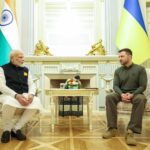Perhaps some believed that the day would not come for a missive from U.S. President Donald Trump on a trade deal. But two days before the deadline, “Friend” India did receive a message—not by way of a letter the American President had earlier sent out to others, but through a no-nonsense post on his Truth Social. And it was indeed a double whammy, reminding India on the trade front and, perhaps more ominously, on its ties to Russia and the issue of “secondary” sanctions, which would probably hurt as much as taxes on trade, if not more.
The President could not have been more direct. “Remember, while India is our friend… we have, over the years, done relatively little business with them because their tariffs are far too high, among the highest in the world. And they have the most strenuous and obnoxious non-monetary trade barriers of any country.”
He added, “Also, they have always bought a vast majority of their military equipment from Russia and are Russia’s largest buyer of ENERGY, along with China, at a time when everyone wants Russia to STOP THE KILLING IN UKRAINE — ALL THINGS NOT GOOD! INDIA WILL THEREFORE BE PAYING A TARIFF OF 25%, PLUS A PENALTY FOR THE ABOVE, STARTING ON AUGUST FIRST. THANK YOU FOR YOUR ATTENTION TO THIS MATTER. MAGA!”
There is no question of the fact that India and the United States have a robust economic partnership, with some even nurturing the hope that it would triple in the next ten years or so. The United States is the largest trading partner of India, with exports and imports rising. And so have the trade surpluses in New Delhi’s favor, to the tune of about USD 42 billion. The major exports from India include pharmaceuticals, garments, gold, and precious metal jewelry, to mention a few. Imports from the United States include electrical machinery, technology and equipment, and organic chemicals. And there is always the hope that the future holds good for exports from India and imports in such areas as petroleum products, renewable energy, and semiconductors.
Quite aside from the so-called barriers to trade, India has been on the receiving end, labeled as being the worst or the “King” of tariffs when it came to the imposition of import duties. For a long time, especially in the first Trump administration, there was this near obsession with Harley Davidson motorcycles’ inability to crack the Indian market. But over a period of time, when the duties were consciously lowered on motorcycles, the din over the Harley Davidson subsided—even if it is not clear whether the reduction of political noise was related to a spurt in sales. In the heat of rhetoric, there is often the tendency to forget the consumer or the customer.
In the present context, there is apparently a frustration in Washington over the slow pace of negotiations on a trade deal, even if both sides have had multiple rounds, and the next one is scheduled in New Delhi by the middle of August. The United States has been able to strike deals with countries like Japan, South Korea, the European Union, Indonesia, and Vietnam—to mention a few—but none fell into the category of “one size fits all.” Each had to be tailor-made—some deals came with huge investment commitments or one-off buys of commercial jets. Most, if not all thus far, have come away content being in the 15 to 20 percent tariff range.
What hurts India is that it is in that 25 percent category, even if there could be a definite thinking that the numbers could be lowered when a way could be found out of the existing roadblock, which is apparently in the area of agriculture. When New Delhi keeps insisting on national interest, it is constantly reminding Washington of the role agriculture plays not just in politics but in an area that encompasses the meaning of India to include society, economy, and even religion. For instance, on the subject of dairy imports, India has apparently told the United States that it goes much beyond technical and commercial parameters but is one that has “deep social and cultural sensitivities.” The vegetarian certification requirement of India means that dairy products must come from animals raised on a strict vegetarian diet—something that the United States may not be able to comply with.
More than the hammer being dropped on India on trade tariffs, it is the more worrisome sledgehammer that is on the anvil by way of Russia and the import of “cheap” or deeply discounted oil. Add to this the continuing gripe of India’s purchase of Russian arms which, incidentally, is on the way down. President Trump, in his tariff message, has said that India would have to pay a “penalty” for the purchase of Russian oil but has not specified what it would be. The President has previously spoken of a 100 percent tariff, which would naturally scare the wits out of India, China, and Brazil; but this is substantially lower than a pending Senate legislation of a 500 percent tariff that has been currently put on hold at the bidding of the White House.
Conveniently forgotten in the ongoing tirade against India subsidizing Russian war efforts in Ukraine is the role of Europe and the extent to which they have bankrolled—or continue to—Vladimir Putin’s war over the last three years.
“Here’s what I would tell China, India, and Brazil: If you keep buying cheap Russian oil to allow this war to continue, we’re going to tear the hell out of you and we’re going to crush your economy, because what you’re doing is blood money,” said Lindsey Graham, Republican Senator from North Carolina, who has the support of 84 other Senators in this broad bipartisan Russian sanctions bill proudly referred to as the “economic bunker buster.” That it is only natural for an oil-scarce country like India to source from anywhere it can for a low price is a kind of economic rationale that means little in political rants.
Disclaimer: The opinions and views expressed in this article/column are those of the author(s) and do not necessarily reflect the views or positions of South Asian Herald.






